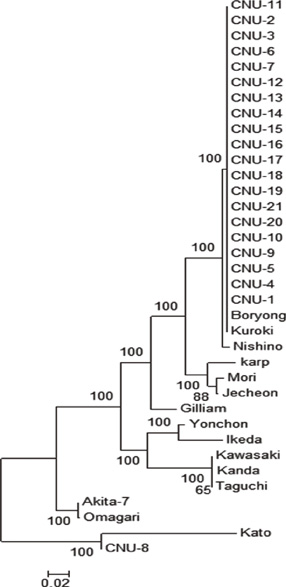J Korean Med Sci.
2013 May;28(5):667-671. 10.3346/jkms.2013.28.5.667.
Inappropriateness of Quinolone in Scrub Typhus Treatment Due to gyrA Mutation in Orientia tsutsugamushi Boryong Strain
- Affiliations
-
- 1Department of Infectious Diseases, Chonnam National University Medical School, Gwangju, Korea. iammedkid@naver.com
- 2Department of Laboratory Medicine, Chonnam National University Medical School, Gwangju, Korea.
- 3Department of Microbiology, Chonnam National University Medical School, Gwangju, Korea.
- 4Research Institute of Medical Sciences, Chonnam National University, Gwangju, Korea.
- KMID: 1777552
- DOI: http://doi.org/10.3346/jkms.2013.28.5.667
Abstract
- The use of quinolone for treatment of rickettsial diseases remains controversial. Recent clinical studies suggest that quinolone is not as effective as others in patients with rickettsial diseases including scrub typhus, although the mechanism is not well understood. In this study, we evaluated the mutation in gyrA associated with quinolone resistance. We prospectively enrolled scrub typhus patients, collected blood samples and clinical data from October, 2010 to November, 2011. Among the 21 patients enrolled, one initially received ciprofloxacin for 3 days but was switched to doxycycline due to clinical deterioration. We obtained the gyrA gene of Orientia tsutsugamushi from 21 samples (20 Boryong strain, 1 Kato strain) and sequenced the quinolone resistance-determining region. All of 21 samples had the Ser83Leu mutation in the gyrA gene, which is known to be associated with quinolone resistance. This suggests that quinolones may be avoided for the treatment of serious scrub typhus.
Keyword
MeSH Terms
-
Aged
Aged, 80 and over
Amino Acid Sequence
Anti-Bacterial Agents/*therapeutic use
Bacterial Proteins/*genetics
Ciprofloxacin/*therapeutic use
DNA Gyrase/*genetics
Doxycycline/therapeutic use
Drug Resistance, Bacterial
Female
Genotype
Humans
Male
Middle Aged
Molecular Sequence Data
Mutation
Orientia tsutsugamushi/classification/enzymology/*genetics
Phylogeny
Prospective Studies
Scrub Typhus/*drug therapy
Sequence Alignment
Sequence Analysis, DNA
Anti-Bacterial Agents
Bacterial Proteins
Ciprofloxacin
DNA Gyrase
Doxycycline
Figure
Cited by 1 articles
-
In vitro Antagonism between Cefotaxime and Anti-Rickettsial Antibiotics against Orientia tsutsugamushi
Oh Hyun Lee, Ji Hyeon Baek, Jin-Soo Lee, Moon-Hyun Chung, Sun Myoung Lee, Jae-Seung Kang
Infect Chemother. 2014;46(3):189-193. doi: 10.3947/ic.2014.46.3.189.
Reference
-
1. Raoult D, Roux V. Rickettsioses as paradigms of new or emerging infectious diseases. Clin Microbiol Rev. 1997. 10:694–719.2. Watt G, Parola P. Scrub typhus and tropical rickettsioses. Curr Opin Infect Dis. 2003. 16:429–436.3. Sheehy TW, Hazlett D, Turk RE. Scrub typhus: a comparison of chloramphenicol and tetracycline in its treatment. Arch Intern Med. 1973. 132:77–80.4. Rajapakse S, Rodrigo C, Fernando SD. Drug treatment of scrub typhus. Trop Doct. 2011. 41:1–4.5. Song JH, Lee C, Chang WH, Choi SW, Choi JE, Kim YS, Cho SR, Ryu J, Pai CH. Short-course doxycycline treatment versus conventional tetracycline therapy for scrub typhus: a multicenter randomized trial. Clin Infect Dis. 1995. 21:506–510.6. Kim YS, Yun HJ, Shim SK, Koo SH, Kim SY, Kim S. A comparative trial of a single dose of azithromycin versus doxycycline for the treatment of mild scrub typhus. Clin Infect Dis. 2004. 39:1329–1335.7. Watt G, Kantipong P, Jongsakul K, Watcharapichat P, Phulsuksombati D, Strickman D. Doxycycline and rifampicin for mild scrub-typhus infections in northern Thailand: a randomised trial. Lancet. 2000. 356:1057–1061.8. Tsai CC, Lay CJ, Wang CL, Ho YH, Wang LS, Chen LK. Levofloxacin versus tetracycline antibiotics for the treatment of scrub typhus. Int J Infect Dis. 2010. 14:e62–e67.9. Oh SY, Chung MH, Oh SJ, Son MS, Ahn SW. An open clinical trial to compare the efficacy of ciprofloxacin, pefloxacin, and doxycycline in the treatment of scrub typhus. Korean J Infect Dis. 1995. 27:193–198.10. Botelho-Nevers E, Rovery C, Richet H, Raoult D. Analysis of risk factors for malignant Mediterranean spotted fever indicates that fluoroquinolone treatment has a deleterious effect. J Antimicrob Chemother. 2011. 66:1821–1830.11. Tantibhedhyangkul W, Angelakis E, Tongyoo N, Newton PN, Moore CE, Phetsouvanh R, Raoult D, Rolain JM. Intrinsic fluoroquinolone resistance in Orientia tsutsugamushi. Int J Antimicrob Agents. 2010. 35:338–341.12. Kim DM, Kim HL, Park CY, Yang TY, Lee JH, Yang JT, Shim SK, Lee SH. Clinical usefulness of eschar polymerase chain reaction for the diagnosis of scrub typhus: a prospective study. Clin Infect Dis. 2006. 43:1296–1300.13. Chang WH. Current status of tsutsugamushi disease in Korea. J Korean Med Sci. 1995. 10:227–238.14. Jeong HW, Choi YK, Baek YH, Seong MH. Phylogenetic analysis of the 56-kDa type-specific protein genes of Orientia tsutsugamushi in Central Korea. J Korean Med Sci. 2012. 27:1315–1319.15. Cracco C, Delafosse C, Baril L, Lefort Y, Morelot C, Derenne JP, Bricaire F, Similowski T. Multiple organ failure complicating probable scrub typhus. Clin Infect Dis. 2000. 31:191–192.16. Jensenius M, Montelius R, Berild D, Vene S. Scrub typhus imported to Scandinavia. Scand J Infect Dis. 2006. 38:200–202.17. Jee HG, Chung MH, Lee SG, Kim IS, Chang WH. Transmission of scrub typhus by needlestick from a patient receiving pefloxacin. Scand J Infect Dis. 1996. 28:411–412.18. Raoult D, Roussellier P, Galicher V, Perez R, Tamalet J. In vitro susceptibility of Rickettsia conorii to ciprofloxacin as determined by suppressing lethality in chicken embryos and by plaque assay. Antimicrob Agents Chemother. 1986. 29:424–425.19. McClain JB, Joshi B, Rice R. Chloramphenicol, gentamicin, and ciprofloxacin against murine scrub typhus. Antimicrob Agents Chemother. 1988. 32:285–286.20. Maurin M, Raoult D. Bacteriostatic and bactericidal activity of levofloxacin against Rickettsia rickettsii, Rickettsia conorii, 'Israeli spotted fever group rickettsia' and Coxiella burnetii. J Antimicrob Chemother. 1997. 39:725–730.21. Botelho-Nevers E, Edouard S, Leroy Q, Raoult D. Deleterious effect of ciprofloxacin on Rickettsia conorii-infected cells is linked to toxin-antitoxin module up-regulation. J Antimicrob Chemother. 2012. 67:1677–1682.
- Full Text Links
- Actions
-
Cited
- CITED
-
- Close
- Share
- Similar articles
-
- Significance of IgG and IgM antibodies in the diagnosis of scrub typhus and evaluation of rickettsia tsutsugamushi strain Boryong as a diagnostic antigen
- Severe Scrub Typhus Complicated by Myofascitis Due to the Taguchi Strain of Orientia tsutsugamushi
- Molecular Cloning of the Major Immunogen of Orientia tsutsugamushi Thai Strains and Development Passive Hemagglutination Test
- Pulmonary Artery Thrombosis Associated with Scrub Typhus
- Cellular and Systemic Interactions of Orientia tsutsugamushi with Mammalian Host



